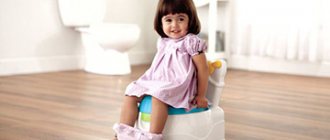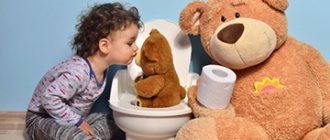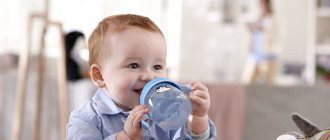Difficulties of early training
Proponents of natural motherhood and parenthood promote early potty training by starting children from the first months of life. Many of them are convinced of the correctness of their actions, since up to a certain age, children actually relieve themselves immediately after or during feeding. Therefore, parents believe that the child has mastered the skill of controlling discharge.
In addition, some mothers associate their child's ability to go to the potty with the sound of pouring water. This method also does not reflect the child’s real understanding of the process of urination, but is a reflex reaction that may disappear over time.
After 9-12 months, the child may stop defecating in this way. This is due to the fact that the baby begins to understand the degree of fullness of the bladder and is not ready to sit on the potty at a time convenient for the parents. During this period, it is important to remain patient and allow the child to independently develop control over the discharge.
Forcibly placing or holding a child on the potty against the child's wishes leads to the development of a fear of the potty.
What can't you do?
Parents need to understand that their behavior and reactions will influence the potty training process. Therefore, you cannot scold or show dissatisfaction if something goes wrong. If we joyfully praise a child for success, then we simply do not notice his mistakes. After all, no adult wears pants, so the baby will definitely learn to control his body.
You cannot force a child to use the potty. If he was scared of something, or the first meeting was unsuccessful (he fell, got hurt), he’s simply not ready, it’s better to leave him alone for a week or two.
You can’t start potty training if your baby is sick, stressed, or something new and difficult is happening in his life.
If the mother knows the basic secrets, is determined but friendly, joyful and affectionate, she will be able to potty train her baby quickly and without any problems.
Optimal time for training
The ideal period for introducing a child to a potty is the age of 1.5-2 years. At this time, the baby begins to realize the uncomfortable sensations from wet or dirty pants. Parents should begin to explain to the child the purpose of the potty and show it by example (using toys).
The age of final formation of control over secretions is limited to 3.5-4 years. Therefore, the learning process can be quite long, especially if the child does not attend kindergarten. Employees of preschool institutions note that children master the skill much faster in a group, and children in the nursery group are quite successful in going to the potty.
Do not forget that age limits are very arbitrary, since each child is individual. Some babies acquire self-care skills at 14-16 months, while others only at 2-2.5 years. Therefore, there is no need to stigmatize a child for mistakes and failures, but to patiently help him cope with the problem.
When is a child ready to learn toilet skills?
And psychologists are sure that even if you start putting a child on the potty at 8-9 months, and he successfully empties into it, then we are talking only about a reflex, and not about a conscious acquired skill.
There is no point in talking about any control over urination at this age. For the simple reason that the baby’s nervous system is not yet developed enough for this.
Children begin to control the processes of urination and defecation no earlier than they are 18 months old, or even later.
A child begins to control the processes of urination and defecation from approximately 18 months. Which is justified physiologically. Therefore, you should think about starting a baby’s toilet education no earlier than he turns 1 year old.
Of course, you can start introducing the baby to the potty before the age of one, but, as many have seen in practice, you will simply increase the training time.
Both children whose parents used early planting and children who began to learn to go to the potty at one and a half years old begin to consciously control their bowel movements at the same age (at 18 months - 2.5 years during the day, and at 3-3 .5 years – at night).
And this has nothing to do with learning. It's all about the readiness of the child's nervous system. Another thing is that there are no identical children. And everyone develops according to their own schedule. Mom and dad shouldn't worry about this at all. Sooner or later, all toddlers start peeing and pooping in the potty.
To start potty training your child, make sure he is fully physically and psychologically ready.
What signs may indicate that a child is ready to begin learning “potty science”?
- The baby sits up and walks independently.
- He can take off and put on his pants himself.
- The baby is already able to inform his parents about his desires using words or gestures.
- The child successfully imitates his elders.
- Understands when requests are made to him.
- Follows adult directions.
- And shows interest in praise and encouragement from mom and dad.
If all this is about your baby, then it’s time for him to give up diapers and start managing his needs, almost like an adult.
You can start potty training your baby if he is completely psychologically ready. In addition, the baby must be completely healthy physically
About child readiness indicators
A child's readiness to use the potty can be assessed by several signs. They are associated with the initial stage of understanding the act of urination and defecation, and the formation of control over the sphincters.
Indicators:
- The child defecates every 2-3 hours.
- The baby points out to his parents that his pants are wet.
- The child can sit steadily on the potty for several minutes.
- Understands the meaning of the phrase “Sit on the potty.”
- Distinguishes between the concepts of “pee-pee” and “ka-ka”.
- Able to sleep for several hours without urinating during sleep.
- Knows how to take off and put on diapers or panties.
It is important that the child himself expresses his readiness and desire to sit on the potty. Emotional readiness is when the baby recognizes the desire to defecate and takes steps (patience) to do so in the designated place.
When to start potty training your child: signs of readiness:
https://www.youtube.com/watch?v=n88v5wDCy1Q
Various potty training techniques
There are many methods for potty training babies. Many of them are based on parents' personal experiences and may not be suitable for other children. However, the main methods of potty training are based on the work of preschool teachers. They have positive responses and are used not only in kindergartens, but also for potty training at home.
Techniques:
- 10 tights – replacing diapers with tights.
- Training in 7 days.
- Training in 3 days.
- Family example - demonstrating that parents also use the toilet.
- Play form (training in 1 day) - using rubber toys.
When is it better to wait for innovations?
- But do not rush into any innovations if the child is sick or has just recently suffered from some illness. Let the baby recover.
- If any changes occur in your family (the birth of another child, a change of place of residence, a crisis in family relationships, etc.), then it is also better to temporarily abandon actively teaching your child new skills.
- Well, and, of course, if you see that your little one does not have any of the above signs of readiness, wait to potty train your baby until they appear.
Always remember that your child is an individual. He is not like any other baby. So why should he start going potty when the neighbor's little one does? Don't look up to anyone. Start only from the physical and psychological readiness for training of your little one.
Potty for girls
The main stages of developing toilet skills
The periodization of the stages of teaching a child to control secretions was compiled by psychologist Alexander Kazmin. He specializes in working with young children and in his book “Diary of Early Child Development from Birth to 3 Years” he indicates the time frame for the formation of potty training skills. These age ranges are described conditionally, taking into account average age indicators.
| Approximate time frame for skill formation | Skill characteristic |
| 14 months | Reaction to soiled pants |
| 18 months | The desire to go to the toilet is accompanied by restless behavior |
| 22 months | With the help of gestures and sounds, the child tries to show the desire to have a bowel movement. |
| 2 years | Pants can remain dry for 2-3 hours. The child knows how to take off his underpants independently before sitting on the potty |
| 2 years 5 months | May indicate a desire to sit on the potty |
| 3 years | Able to sit on a potty, relieve major and minor needs, and put on pants |
How to properly potty train a small child
According to many parents, potty training should be done when the child begins to walk well and can sit firmly in a chair. This is usually 12-15 months of age. But even at such an early age you should not begin active training activities.
It is enough to buy a potty and show your child its purpose more often. This can be done conveniently using rubber bath toys, which are pre-filled with water. This is how the baby is shown an imitation of the urination process.
At the same time, you can begin to sit the child on the potty. At first they do this without taking off their pants, so as not to scare the baby. You cannot hold your child on the potty by force, even if he immediately tries to get up.
Best time to sit down:
- after a night's sleep;
- before and after meals;
- before and after nap;
- before and after a walk;
- before bedtime.
The next step is to stop wearing diapers while you're awake. The baby must see how the process of bowel movement occurs. The child understands and grasps the connection between the process and its sensations.
Every independent attempt to go potty should be encouraged. However, this must be done only with words. Giving gifts or desserts in response to going potty may create the wrong associations in your child.
The baby will quickly learn the skills of neatness in the family by watching older children. If they are not there, then during training it will help to minimize the clothing on the child or equip his pants with loose elastic bands.
It is worth installing the potty in a place where the child spends most of his time. At first, children realize the desire to relieve themselves too late, so the closer the potty is, the more likely the child will have time to sit on it.
Books and cartoons can be useful in teaching, where the main character learns to go to the potty and successfully masters it. It would also be a good idea to take your child with you to purchase the device and let him choose the potty on his own.
The average time to potty train a child ranges from 3 weeks to 4-5 months. It depends on the age of the baby and his emotional and physical readiness. If it is necessary to teach a child neatness skills in a short time, accelerated methods can come to the rescue.
How to start potty training your child
The process of potty training a child is not always as simple as it seems, and so that it does not drag on for a long time, you should prepare for it in advance. Namely, choose the version of the night vase that is suitable for your child and choose the right moment so that the child correctly perceives and begins to use it for its intended purpose.
How to choose a potty that's right for your child
You definitely shouldn't buy the brightest, most expensive, or most interactive pot. Color in this case does not play a role at all, the main thing is that it is not repulsive and unpleasant for the child. The most expensive is not always the most convenient (this is very important!). And a potty that sings, shines with all the colors of the rainbow or dances will definitely not motivate your baby to pee in it.
When buying a pot, you should pay attention to:
- Pot size. It must be suitable for the child so that he does not fall through and in the process does not interfere with the natural process.
- Form. It is better if it is anatomical. Then the baby will definitely be comfortable. It is also good if there is a small back, like a saddle, this will ensure a more comfortable sitting for the child during the process.
Expert opinion: “For girls, a round-shaped pot is better, and for a boy, an oval one with a protrusion in front to avoid splashing”
- Material. You can buy a handmade porcelain or copper vase, but firstly, it is unsafe, because... if a baby hits something on it, ceramics and porcelain break easily, and secondly, these materials do not hold the ambient temperature well. Therefore, plastic will be optimal for the baby’s sensations - it will never be too cold or hot, because... always adapts to the room temperature (unless, of course, you keep it on the balcony).
- Sustainability. It is very important that at the first contact with the potty the child does not kick and, even worse, does not fall from the potty. Otherwise, it will be a long-term, curable unpleasant experience and you will have to take a rather long break in the training process.
- No distracting elements. The simpler the product, the easier it will be to get accustomed to using it. Extra accessories and elements will only distract attention and interfere with the process.
Pink cat pot
Potty suitcase
Duck pot
Potty toilet with toilet paper holder
Transformable pot
Pot with lid
Potty with steering wheel
Giraffe potty and tablet potty
Potty frog and potty penguin
Potty bear
Pink pot with lid
Potty with lid pink chair
Potty ladybug
Pots with stars
Different pots
Blue pot
Multi-colored pots with lids
Multi-colored pots with lid
First meeting
In order for the process of getting used to the potty of a child, especially taking into account the fact that modern children wear diapers from birth, to go as easily as possible, it is very important to choose the right moment.
See also: What is child custody and how to arrange it correctly
Under no circumstances should you overwhelm the baby with an “acquaintance”: “Look at this thing, put your butt here and let’s pee/poop there!” This can both repel the child and arouse playful interest in a new contraption, in which first you will need to put all your toys, porridge and anything else that comes your way.
Before choosing the right moment, you can talk with your friends, read mommy forums on the topic of potty training. This does not mean that you need to apply everything that is written or said there, but perhaps something practical and suitable for you will be found there.
We advise you to pay attention to the following “secrets”:
- The first time the child should be placed on a dry and warm potty.
- The child must be in a good mood and feeling well.
- The child wrote for the last time more than an hour and a half ago.
- The time spent on the potty should not exceed 10 minutes.
- Planting can be accompanied by watching your favorite cartoon. By the way, there are special videos and cartoons about potty training, you can use them.
If things don’t work out the first time, give your child time to calm down and forget the unpleasant sensations. There is no need to aggravate the situation with increased persistence, much less rudeness and threats. This will only make the situation worse.
How to potty train a child in 7 days
You can potty train your child in 1 week. The main thing is to show consistency in the parent’s actions.
You can start classes using this system only from 1.5 years old, provided that the child understands the requests of adults and also knows how to take off his panties independently.
During this period, the child will develop an understanding of the purpose of the potty and his needs.
Methodology:
- On day 1, you need to stop using diapers and replace them with regular panties, supporting them with an explanation that the baby is already old enough for this step. Immediately after sleep, you need to sit your child on the potty to urinate. If all else fails, you need to re-seat the child on the potty every 25 minutes;
- On day 2, you need to repeat sitting down and carefully monitor the child to notice signs of the desire to defecate. On day 3 you need to stop using diapers while walking outside. It is necessary to ask more often whether the baby wants to go to the toilet. In addition, you can take the potty with you;
- From days 4 to 7, the intervals between bowel movements become clear, so it’s worth putting your baby on the potty every 1-2 hours (depending on the child’s needs). If the child is too interested in playing, you need to remind him about the potty. After successful urination or defecation, you need to praise the baby.
How to proceed?
The main condition for success is regularity. If you start teaching your baby to use the potty, you should do it every day from morning to evening.
Today you can find methods of “express potty training” in three days, some universal seven-day “courses”. All this, to put it mildly, is not entirely correct in relation to children and their mothers.
Kids are so different that one can actually master the potty in a week, while another needs a longer time to master a wonderful subject. The point is not even that the child understands what is required of him - everything is in order with this. He needs to learn to correlate his physiological desires with his capabilities.
How to potty train a child in 3 days
It is quite possible to potty train a child within 3 days. This method is applicable if you need to go on a trip or go to kindergarten. You shouldn’t get your hopes up that in 3 days you’ll be able to completely stop using diapers, but this method will help develop an understanding of the purpose of the potty and teach your baby to go potty at home.
It is best to use the training method from 1.5 to 2 years:
- 2 weeks before the expected training, you need to buy a potty and children's underpants. Every day you need to explain the purpose of the device and create a pleasant image;
- Throughout the 3 days while the baby is potty training, the mother must be constantly nearby to provide physical and emotional support. It is also necessary to have books, films and toys on hand to distract the child and provide him with leisure;
- On day 1, the diaper is replaced with panties or the baby is stripped naked, if the air temperature allows. Parents need to carefully monitor the external manifestations of the child's desire to defecate. It is necessary to sit your baby on the potty every 30-60 minutes. The child should be praised for every successful attempt. The diaper can be put on before going to bed at night;
- On day 2, diapers are discarded during walks. Therefore, it is worth walking close to home or taking a spare set of clothes. You need to go outside only after successful urination with obligatory praise of the baby;
- On day 3, it is worth adding 1 more walk to reinforce the understanding of the need to ask to go potty. You also need to put your baby on the potty before and after meals, sleep and walks.
Is it possible to potty train a child in 1 day?
Potty training a child in 1 day is a very difficult task. This technique is best mastered by children from 2 years of age.
Methodology:
- To carry it out you will need a rubber toy, underpants and a potty.
- Having secluded yourself with the child so that he is not distracted by strangers, you need to use a rubber doll with water inside to show the process of urination and ask him to repeat the same thing, sitting the baby on the potty.
- Thus, you need to repeat the sequence of actions more often and put the child on the potty at every opportunity.
Many note the inconsistency of this technique, however, its supporters argue that it helps to form an initial understanding of the natural needs of the child.
When to start potty training your child
If you don’t have to adhere to the “generally accepted” rules, then the age at which you should introduce your precious child to a new friend is determined by you – and only you (more precisely, your child!).
But besides you and your precious baby, there are also grandmothers whose children (that is, you) have been peeing in a potty since they were 3 months old, and reading Pushkin since they were 1 year old. There are pediatricians who look at diapers in surprise during the next examination after a year.
There is no single (and most importantly correct) opinion on how and when to potty train a child. And it’s far from a fact that the training method that your friend, neighbor or mother-in-law used will be suitable for you and your baby.
There are familiar cases when babies suffering from severely irritable skin sat on the potty as soon as they learned to sit at all. And there are the opposite, when the “war” for peeing in a specially designed container dragged on for up to 3 years.
Child psychologists determine the approximate age of potty readiness to be about 2 years old; it is at this time that the child’s nervous system is sufficiently developed to form these skills.
Signs your child is ready to go potty:
- The child understands the meaning of the words “pee” and “poop”
- Feels discomfort and indicates dirty or wet laundry
- Doesn't pee for quite a long time (1.5-2 hours)
- Doesn't play with the potty
Retraining
It happens that a child who has mastered the use of a potty may suddenly stop defecating in it. This behavior in children is typical after stressful situations, age-related crises, or is a consequence of too early training.
Some of the most common reasons for the need to re-potty train include:
- Crisis 3 years. Characterized by negativism, stubbornness and refusal to perform usual actions.
- Teething . Severe pain prevents the child from focusing on sensations.
- Changing your usual lifestyle. Stress from moving, a long absence from mom, or going to kindergarten.
- Difficult emotional situation in the family. Screaming and showdowns affect the child’s subtle psyche and disturb his calm.
When retraining, it is important for parents to find the reason for the child’s refusal to use the toilet and try to overcome it. In addition, the use of different potty training methods helps twice as much, since the baby may not agree to go to the potty according to the pattern familiar to him.
Potty training a girl and a boy: are there any differences?
Psychologists and early childhood development specialists do not point to gender differences in potty training. But parents note that girls master the skill a little faster than boys.
On the one hand, this is associated with the fact that girls spend more time next to their mother and try to imitate her in everything. However, girls are often embarrassed to defecate in the presence of people, so they endure it for a long time and do not have time to sit on the potty.
When potty training boys, it is worth paying attention to the method of emptying. First, the baby must master the skills of using a potty in a sitting position, since children usually recover from major and minor needs almost simultaneously.
After the boy has learned to use the potty for its intended purpose, he can be shown how to urinate while standing. Before doing this, you must first purchase a deep pot with a bolster that prevents liquid from splashing.
When to teach?
If a mother literally starts holding her baby over a basin or bathtub from the age of three months, this is not bad, but it has nothing to do with early potty training. In order for a child to begin using the potty for its intended purpose, awareness is needed, which will only occur at the moment when the child is physiologically ready, and his brain is sufficiently mature to understand the connection between the natural process of defecation or urination and the child’s potty.
The following conditions must be met:
- A child’s bladder can withstand quite long periods of “abstinence”: the baby remains dry for at least two hours.
- The child is increasingly waking up in the morning in a dry diaper (or clothes, if a diaper is not used).
- The baby does not like a dirty diaper or pants, and he clearly expresses his dissatisfaction and worries about this.
- Regular (at about the same time) stool is established.
- The baby knows why secluded parts of the body are needed and understands the meaning of words associated with urination or defecation.
It is these features that must be taken into account in order to understand at what age to potty train a child. A one and a half year old baby is able to easily and quickly master children's wisdom. In any case, you shouldn’t wait longer than two years.
Thematic material:
- Panties for potty training
- Potty training in 7 days using the “Satisfied Baby” system
Potty phobia
Sometimes it happens that the baby does not accept the potty or stops using it. This behavior may mean that for some reason the device has begun to cause fear in the child. Therefore, it is extremely important for parents to find out the cause of fear and make every effort to eliminate it.
Among the main causes of fear are:
- Shyness.
- Psychological unpreparedness for training due to early age.
- Physical factor - an uncomfortable feeling while sitting on the potty (due to temperature or instability).
- Punishment for mistakes.
If your baby throws tantrums and doesn’t want to sit on the potty, you should temporarily put off trying to train him and put the device away. You can repeat teaching your child neatness skills after a few weeks.
Psychologists recommend starting it by sitting toys on the potty and forming a positive image of the emptying process with the help of therapeutic fairy tales. Over time, the child’s fears will subside, and the skill of using the toilet will certainly be learned.
Prohibited Methods
Some parents, in the hope of quickly potty training their child, use methods that traumatize the child’s psyche and create irrational fears in relation to the process of bowel movement.
These methods are considered:
- Physical and verbal punishments for misfires and mistakes.
- Comparison with other children.
- Planting during times of physical ailments and stress (vaccinations, teething, illness).
- Constantly planting and holding the child on the potty until the result appears.
How to choose a potty for a baby
It is easiest to potty train a child if the child himself took part in his choice.
But before trusting your child with such a complex task, it is necessary to limit the choice to the most suitable options:
- The best material is plastic. A plastic pot is easy to clean, maintains a comfortable temperature and is cheaper than products made from other materials.
- Convenient shape. All modern pots are equipped with a special recess for a comfortable feeling during use. For girls, a device with a round recess is selected, and for boys, an oval one is selected.
To potty train your child faster, you need to make the process as comfortable as possible. The shape of the vessel is different for boys and girls - Sustainability . The pot should be heavy enough and not slip on the floor. This is important, because when the baby wants to use the potty on his own, he should not fall and get scared.
- Simplicity of design. Drawings, bright stickers and music can distract the child from the actual purpose of the potty, and form the image of another exciting toy.
Which pot should I buy?
You need to buy the “right” pot - success also depends on this. This important hygiene item should evoke pleasant emotions in the baby and provide a comfortable feeling. The potty should not be metal: a cold touch is unpleasant, the child may categorically refuse to use the item.
Plastic, cozy and beautiful - this is how the first pea should be. Check for any flaws or cracks in the plastic that could scratch or cause pain. For girls, a round hole is better, for boys - an oval one (these are the physiological features of the structure).
The potty must be stable so that the child cannot fall from it or accidentally turn it over. It’s good if there is a backrest - it will be more comfortable to sit. But musical pots that make sounds, equipped with additional game elements, should be abandoned. A child should sit on the potty not for play, but for a specific task.
Useful tips from Dr. Komarovsky
The famous pediatrician Evgeny Komarovsky has repeatedly commented on potty training children.
The main thing that the doctor points out is to start teaching neatness skills only when the child is ready for it physiologically, and not because of comparison with other kids.
Komarovsky writes that the age of formation of toilet skills is 1-3 years. By the age of 3, the purpose of the potty and the ritual of its use are finally learned. Previously, potty training by developing a conditioned reflex to sound (“pee-pee”) is inappropriate, since after 1-1.5 years an awareness of natural needs begins to appear.
According to the pediatrician, the scheme for using the potty is as follows: full bladder - sitting on the potty - urination. Reflex emptying “sound – filling the bladder – potty” does not correspond to the correct understanding of the process of urination and defecation.
Komarovsky's recommendations:
- Potty training should begin no earlier than 1.5 years.
- Conscious use of the potty may only appear by the age of 3, so parents should not actively interfere and try to teach the child as early as possible. It's best to put off trying for a few months and then try again.
- One of the most important signs of readiness for toilet training is the ability to show parents in some way the desire to defecate.
- During training, parents must be consistent and not stop planting for a few days and then start again.
- It is best to potty train a child in the summer, when the child is not limited by a large amount of clothing.
- A good mood is the key to successful training.
- At first, you don’t need to completely give up diapers. They can be left for sleeping, walking, traveling.
- Planting on a pot should begin after sleep, eating or before a walk.
- Don’t focus on mistakes and give a lot of praise when you succeed.
Using the potty can be turned into a ritual game:
- take off your pants;
- sit on the potty;
- relieve yourself;
- dry off;
- put on pants;
- take out and wash the pot;
- to wash hands.
Potty training is an important stage in a child's growing up, so parents should act gently and actively support the baby, not skimping on praise.
Patience and a positive attitude will help parents and the baby cope with this difficult task and master a new type of activity.
Article design: Svetlana Ovsyanikova
Potty training your baby step by step
- Place the potty you bought in your child’s room and try to clearly explain to the baby what this new item is and why it is needed.
- If the baby is not immediately imbued with any good feelings towards what he considers an outlandish thing, just give him time to take a closer look and get used to finding the potty on his territory. If the little one reacted quite kindly to his first toilet device, you can move on to the next stage.
- Place your child on the potty for a few minutes 2-3 times during the day. In this case, you do not need to take off your panties (diaper) yet. Just let the baby begin to take the potty for granted. This stage usually takes 7-10 days.
Be patient and kind. Otherwise, you risk causing persistent rejection and protest in your little one.
- Then you can try to plant the baby without pants (diaper) 2-3 times a day. At the same time, do not try to catch when the baby wants to pee. So you can only scare him. And the child, on the contrary, will try to hold back urination while sitting on the potty. But you are striving for the exact opposite. Therefore, there is no need to rush. Let everything take its course. Allow at least 1-2 weeks for this stage.
- During which you can try to more clearly form in the toddler’s mind an idea of the purpose of the potty. How to do it? Every time you take your baby's diaper off, you can defiantly throw it into the potty. You can ask the older child to relieve himself in the potty in front of the younger one. After all, kids very willingly imitate their elders. And this method very often turns out to be the most effective. Do not forget to constantly explain all your actions to your baby. You shouldn’t underestimate the power of words, even if it seems to you that the little one doesn’t understand everything. This will take another 1-2 weeks.
- Now you can start putting your child on the potty when it seems to you that he really needs it. For example, after sleep, food, walk. Watch the baby carefully. Usually, when kids want to go to the toilet, they freeze, concentrate, and stop playing. It is at such moments that you can offer your little one a potty. Again, allow 1-2 weeks for this stage.
- And only after consistently going through all the stages can you begin to teach your child to independently use the potty, which should always stand in one place and be accessible to the toddler. Explain that now the baby will sit on the potty on his own when he needs to. And rehearse the entire toilet ritual with him until it becomes automatic. Don't skimp on praise and encouragement. After all, for a child they are the most important engine of progress.
You can potty train your child for six months, ten, or a year. It's very individual. For some the process takes longer, for others less. Be patient and kind. And your success is guaranteed.
Do not scold or punish your child if he is not learning toilet science as quickly as you would like.










